Great vintage collection: the electronic calculator

When doing your math homework you were happy with every tool dat could make your calculations quicker. In the 1970’s you could choose between learning to operate the slide rule (see vintage collections : the slide rule) or when funds were plenty…buy an desk top calculator. Or in the 1980’s as I experienced…why on earth did I learn to make calculations on paper when there was this great thing called handheld electronic calculator? Now these tools are vintage fun and getting more collectable.
The calculator as we now know it. – brAun vs Iphone
Most people nowadays encounter the calculator as a part of their phone (mostly as an app). But Steve Jobs, our Iphone creator, did not invent the calculator look and feel at Apple HQ all by himself. Does this looks familiar?
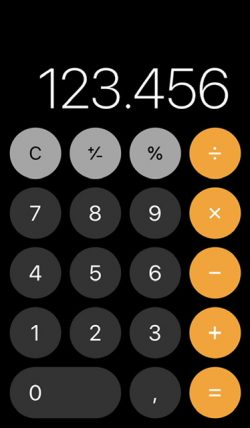
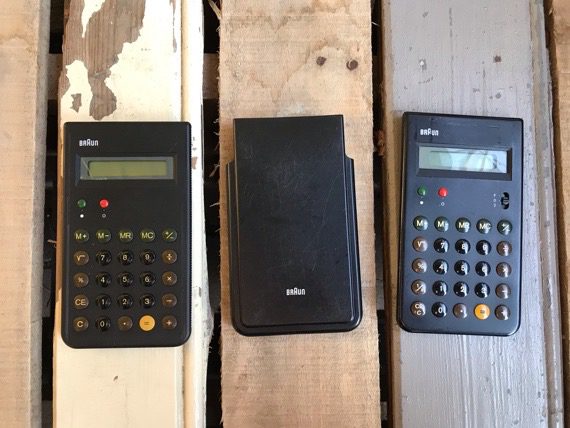
So our current calculator was actually based on a vintage calculator design by Braun from the 1980’s, with special thanks to mr. Dieter Rams. This should get you interested in some calculator history. If not, just check out some of the pictures in this article and I am sure you will understand the fascination of calculator collectors.
Different displays, styles and materials
As shown in the first picture of this article, there are many different shapes of calculators. Over time the look and feel changed from brick like handheld models, derived from their large desk dwelling brothers and sisters. Like this Adler.

Which finds it’s way to machines like these from the same period, early 1970’s. Also notice the green display. The Roger below has many of the same features including the use of metal. Around the same time there are calculators with the red LED display. Both talking up a lot of energy from the power cells so these were later replaced for grey-ish LCD displays. A good tell to pinpoint the age of a vintage calculator!
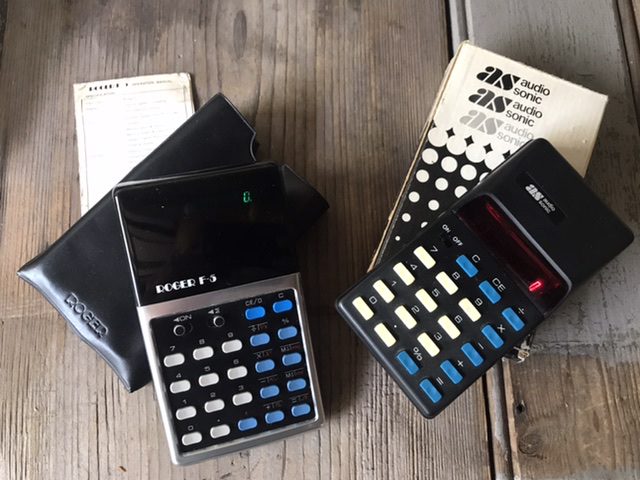
Texas Instruments and Hewlett Packard are best known for their calculators because they stoot at the cradle of development. It was Texas Instruments that came up with the first prototype in 1967 of a handheld calculator, where Hewlett Packard created the first pocket size scientific calculator in 1973. The models shown below being from a later date but show that HP and TI were going strong, building on their early developments.

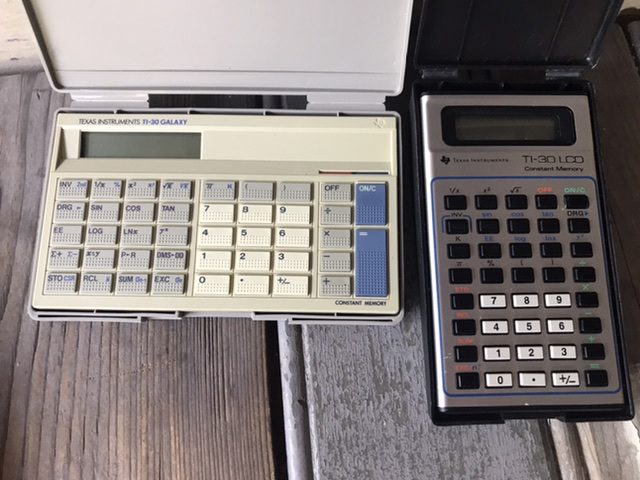
A standard calculator was produced by many different companies since it was a high volume market. Where the first calculators were very expensive and only bought by scientist and administrators, they came available to the general public within a decade after development. Amongst the different names you find Casio, Audi Sonic and Canon, just to name a few.
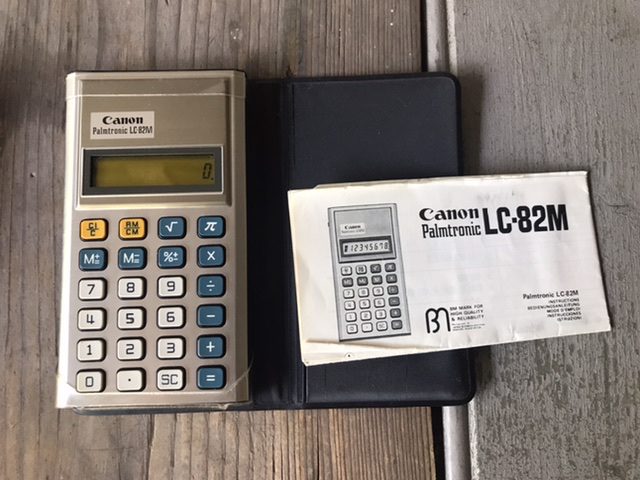
Vintage non mathematic calculators
Mainstream was the standard or basic calculators. Then there were the mathematical and more complex calculators. These could have all kinds of scientific functions and later on even graphical functions. They slowly were slowly developing towards mini computers. A third group of calculator was made up by the few exceptions to the rules, like the one below. Calculators made for a very specific job.

Featured here is a special Biorhythmic calculator that only does that. One needs to input certain dates so it can calculate your personal biorhythms, something that was fashionable in the mid-1970’s. There are also 3 yellow and 3 red leds installed for these functions. So it has the look and feel of a standard 1970’s calculator but is actually a very specific handheld early computer / calculator. Very specific calculators were also produced for navigation, specifically airplane piloting calculations.
Accessories to vintage calculators – full set – sleeves, boxes, manuals
When collecting, you would of course look for working calculators. In addition it is great if you also get a manual with it, or even the box it was sold in. This would make up a “full set”. Perhaps even a warranty card or soft sleeve could make part of this package.
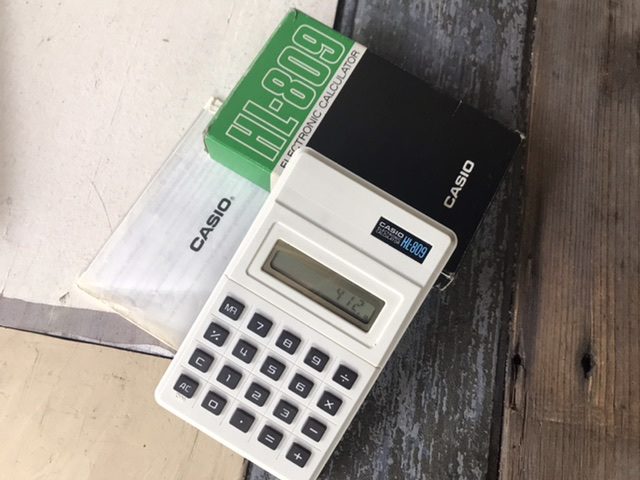
Above you see a Casio model HL-809 with it’s original box and manual and clearly in working order. It gives a better understanding of the way the machine works, as well as the kind of marketing involved to sell this. It seems the emphasis lies on the “electronic” bit with this one. Below a picture of the sleeves the earlier model calculators were often sold in. They have a logo imprinted. The brown HP carrying case was actually an extra accessory to give extra protection to the user that often transported their calculator.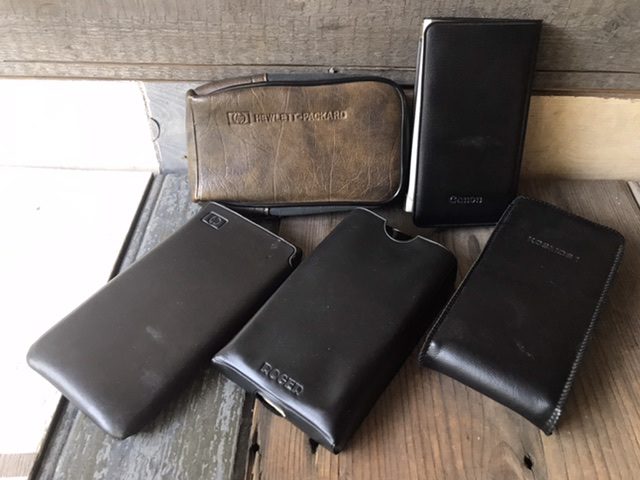
Another interesting designed vintage electronic calculator is the M75 by Aristo. That is right the Brand from the German Dennert & Pape company. This company is well known for their high quality slide rules. Since the slide rule market was dwindling and the electronic calculator market quickly growing it was in 1975 that they launched their first mathematical calculator. It had a thin sleek design (slide rule shape?) with red led display. The yellow folder shows additional models from the Aristo calculator range at that time!
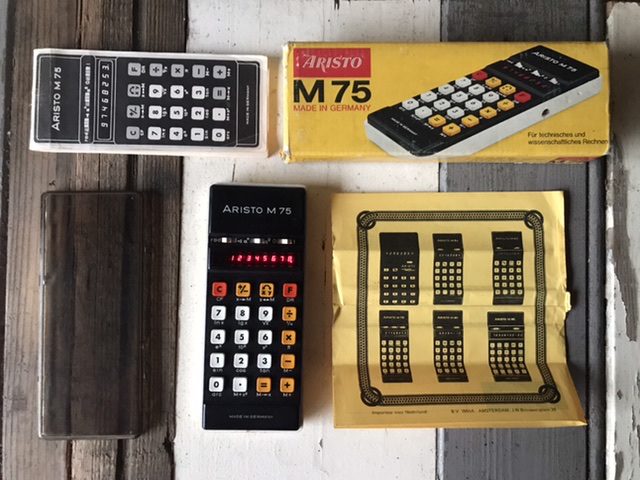
vintage electronic calculator
To conclude
The vintage electronic calculator is fun to use today and still pretty handy in my opinion. The history surrounding them make them an important piece of calculating history, specially because they were around only for a few decades. The live on in the current 2020 editions of handheld calculators with graphical interface and color screens…but they will never be the same.


One thought on “Great vintage collection: the electronic calculator”